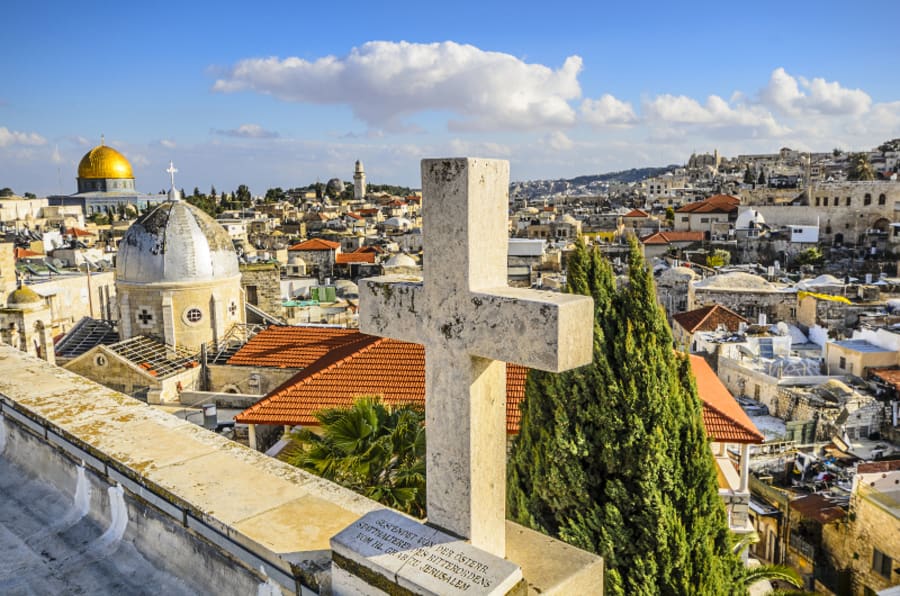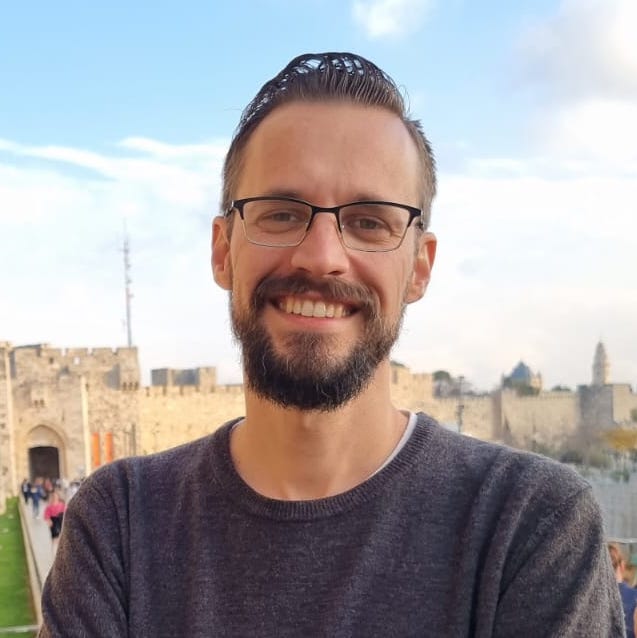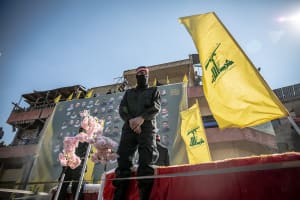How “holy” is Jerusalem…really? Judaism, Christianity and Islam each have their claim (Part 2)
In part two of this 3-part series, we will explore Jerusalem as the Christian Holy City

We often hear about Jerusalem as “The Holy City” and that it’s holy for three major world religions; Judaism, Christianity, and Islam. But how true is that statement? Is it equally holy in all three religions, or do some of these religions see it as more holy than the others do?
Since each one of these religions has ruled over Jerusalem at different points in history, we can get some clues as to how they see Jerusalem.
We are covering one of the three religions in each one of these articles, and in this, part two, we will look at the Christian claims, and rule, of Jerusalem.
To say that Judaism was the first religion to claim Jerusalem as its own is only partly true. A biblical faith in the God of Israel and the temple service of King Solomon was first – and all these three religions claim ownership of the Old Testament, Solomon’s temple, and the prophets. It wouldn’t be wrong to call this original faith Judaism, but both Christians and Muslims would argue whether today’s Rabbinic version of Judaism is the true heir of that faith.
When Jesus entered the scene, Jerusalem had already been established as the Holy City for the Jewish people. When Jesus speaks of Jerusalem, he cries over the fate he knows will occur just 40 years after him, with the second destruction of the temple in 70 A.D. He goes there to be crucified because a prophet can only be killed in Jerusalem. He is the Jewish Messiah, Jerusalem is where God, and actually He, decided to place the temple, and it’s the spot He chooses to be crucified and buried and resurrected in. But executions don’t occur within the city walls. He is crucified on Golgotha, a hill outside the city.
Wait a minute… does this ring a bell from the previous article? Wasn’t the temple of Solomon originally on a hill outside of the city? Now Jesus is crucified, bringing eternal atonement for the world, on a hill outside of the city. A different hill, of course, but yet a hill outside the city.
When the Romans destroyed Jerusalem in 70 A.D., and when they demolished it completely in 132 A.D., they built a pagan city, Aelia Capitolina on the ruins of Jerusalem. They renamed Israel, calling it Palestine, and persecuted both Jews and Christians. At this point, they deliberately defiled the holy places with pagan temples, but this was to keep alive the memory of where they were.
When the Roman Empire turns Christian under Constantine in 306 A.D., and Constantine’s mother Helena arrives in Israel, the bishop of Jerusalem points to the exact spot where Jesus was crucified. They built the church of the holy sepulcher on it, and the walls of Jerusalem are built around it. Once again, the hill that used to be outside of the city walls became a holy central place within the city walls. The city is, once again, renamed Jerusalem, but the persecutions of Jews didn’t stop. The Christian Romans of the fourth century, or Byzantines as we call them today, adhered to the replacement theology.
Throughout time, many Jewish legends began to develop about the Temple Mount. Christians now use these legends and switch them to be about Golgotha. The burial place of Adam, the first man? Golgotha, of course. The first part of the universe that God created and everything else came from it? Nope, not the Temple Mount. It was Golgotha. The center of the world and the universe? Golgotha, of course.
What about the Jews? They were not allowed to enter the city. Somehow that is an act of revenge for crucifying Jesus, perhaps. This is the first time we see Gentiles taking over Jerusalem and making it their own holy city, usurping Jewish claims.
The Christian claim is that Jesus is the Messiah and, in turn, they are the true Israel, following the Messiah, while the Jews are following the false teachings of the Pharisees. The New Covenant has replaced the Old. The Christians are in, the Jews are out.
And what about the Temple Mount? The maps show it as an insignificant part of Jerusalem. It was probably kept in ruins on purpose, to prove that Christianity is true and Judaism is false. All the while, Jews mourn and pray about Jerusalem as their original capital, about their temple in ruins and their desire to one day return and rebuild their ancient capital.
As Christianity and Judaism split into separate religions, Jerusalem naturally became holy to these two religions, but it never became a major Christian capital in this Byzantine Empire. This is when we first see the difference in the way the religions treat Jerusalem. For the Christians it becomes a holy city, a place of pilgrimage, but it is by no means a capital or an important commercial center.
And then Islam enters the arena in the seventh century. We will speak more about their claims in the next article, but for now all we need to know is that their focus was on the Temple Mount, and that they allowed Jews to live in Jerusalem again for the first time since 132 A.D. In fact, from the seventh century until 1099 A.D., the Christians of Jerusalem lived as a minority under Muslim rule, and their churches and holy places stayed intact because of the Muslim tradition to allow Judaism and Christianity to remain, as long as they paid the “jizya,” the infidel tax. Since the Muslims were not interested in Golgotha, and the Christians didn’t see the Temple Mount as holy, they were able to live in relative peace and also welcome the Christian pilgrims who arrived every now and then.
Until the Seljuk Turks occupied the region, that is. The Seljuks threatened the Christian population and the pilgrimages, triggering the crusades. When the crusaders came, they massacred all Jews and Muslims in Jerusalem in 1099 A.D. and established a crusader kingdom. They didn’t come to establish Jerusalem as the world’s capital, or have the pope reign from there. No, all they wanted was free and easy access for pilgrims to be able to visit all the holy places.
This is also why the crusaders couldn’t hold on to the Holy Land for very long: They never had enough people. They were never more than a small ruling elite over the locals, who were mostly Jews, Muslims, and Byzantine Christians. But they did expel the Muslims from Jerusalem, turned the Dome of the Rock into a church, and called it “Solomon’s Temple” where they instituted the Knights Templar order. And then, in 1187 A.D., Salah el-Din conquered Jerusalem and erased all traces of Christian worship on the Temple Mount.
When the British Empire conquered the area from the Ottomans in 1917 as part of World War 1, they ended a 730-year rule of Islam over Jerusalem. And the British were the first Christian rulers of Jerusalem since the crusaders. But they were really more secular than they were Christians. They didn’t even demolish the Dome of the Rock or turn it into a church; they eventually gave up and asked the United Nations to make a decision on the region’s future. In 1948, they left without implementing the UN’s decision, leaving the region spinning into a civil war, today known as Israel’s War of Independence.
We learn that the Christian rulers of Jerusalem have either been staunch proponents of replacement theology – banning Jews from their holy places – or secular European colonial rulers.
We can point to a few specific individuals who were Bible-believing Christians, such as Lord Balfour who issued the Balfour Declaration in 1917 or Orde Wingate who trained Jewish soldiers for battle in the 1940s, motivated by his Evangelical belief in a Jewish independent nation. But they were always a minority. And while earlier Christian rulers, such as the Crusaders or the Byzantines, saw a great religious importance in Jerusalem, it was never thought of as a capital or homeland.
Christians who subscribed to replacement theology didn’t see any significance in the Jewish people, as they believed that Christians were the new Israel. Neither did they see any religious significance in the land of Israel itself. They never claimed that the land was rightfully theirs because they are the “true Israel.” Their claims were about the holy places, protecting local Christians, and about pilgrimage, not about legal or rightful ownership.
For Jews, Jerusalem is and has always been so much more than just a holy city for pilgrimage. It’s our capital, our history and our future. For the many centuries that Jerusalem was under Gentile rule, Jews continued praying and wishing for Jerusalem to become their capital once again.
Now that it is ours again, it is our capital and it’s flourishing. With almost one million inhabitants – about 10% of all Israelis – it is the largest city in Israel, taking up 48.323 square miles.
Next time, in the final part three of the series, we will take a closer look at the Muslim claims on Jerusalem from the seventh century and onwards. We will see what place Jerusalem has in Islam, and how the different Muslim rulers have treated it, from the Ummayad, Abbasid, and Fatimid, to the Seljuks, Mamluks and Ottomans, and also the short-lived Jordanian rule over East Jerusalem between 1948 to 1967.
Pray for the peace of Jerusalem. May those who love you be secure. May there be peace within your walls and security within your citadels (Psalm 122:6-7).

Tuvia is a Jewish history nerd who lives in Jerusalem and believes in Jesus. He writes articles and stories about Jewish and Christian history. His website is www.tuviapollack.com














